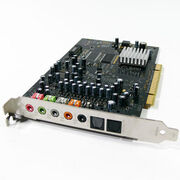
Here we are looking at the sound card

Another perspective on the sound card...

Yet again, the sound card...
A typical sound card includes a sound chip, usually featuring a digital-to-analog converter, that converts recorded or generated digital waveforms of sound into an analog format. This signal is led to a (typically 1/8-inch earphone-type) connector where an amplifier, headphones, or similar sound destination can be plugged in. More advanced designs usually include more than one sound chip to separate duties between digital sound production and synthesized sounds (usually for real-time generation of music and sound effects utilizing little data and CPU time).
Digital sound reproduction is usually achieved by multi-channel DACs, able to play multiple digital samples at different pitches and volumes, optionally applying real-time effects like filtering or distortion. Multi-channel digital sound playback can also be used for music synthesis if used with a digitized instrument bank of some sort, typically a small amount of ROM or Flash memory containing samples corresponding to the standard MIDI instruments. (A contrasting way to synthesize sound on a PC uses "audio codecs", which rely heavily on software for music synthesis, MIDI compliance and even multiple-channel emulation. This approach has become common as manufacturers seek to simplify the design and the cost of the sound card itself).
Most sound cards have a line in connector where the sound signal from a cassette tape recorder or similar sound source can be input. The sound card can digitize this signal and store it (controlled by the corresponding computer software) on the computer's hard disk for editing or further reproduction. Another typical external connector is the microphone connector, for connecting to a microphone or other input device that generates a relatively lower voltage than the line in connector. Input through a microphone jack is typically used by speech recognition software or Voice over IP applications.
Sound cards for computers based on the IBM PC were uncommon until 1988, leaving the internal PC speaker as the only way early PC software could produce sound and music. The speaker was limited to square wave production, leading to the common nickname of "beeper" and the resulting sound described as "beeps and boops". Several companies, most notably Access Software, developed techniques for digital sound reproduction over the PC speaker; the resulting audio, while functional, suffered from distorted output and low volume, and usually required all other processing to halt while sounds were played. Other home computer models of the 1980s included hardware support for digital sound playback or music synthesis (or both), leaving the IBM PC at a disadvantage when it came to multimedia applications such as music composition or gaming.
It is important to note that the initial design and marketing focuses of sound cards for the IBM PC platform were not based on gaming, but rather on specific audio applications such as music composition (AdLib Personal Music System, Creative Music System, IBM Music Feature Card) or on speech synthesis (Digispeech DS201, Covox Speech Thing, Street Electronics Echo). It took the involvement of Sierra and other game companies in 1988 to switch the focus toward gaming.
If you would like further information, follow these website links.:http://blogs.msdn.com/b/larryosterman/archive/2008/07/11/whatever-happened-to-wave-out-mix.aspx
. "Retro Japanese Computers: Gaming's Final Frontier Retro Japanese
^ Detailed discussion of distortion measurement with sound cards